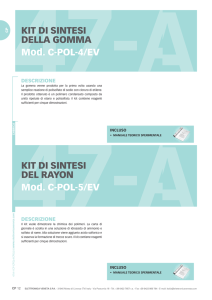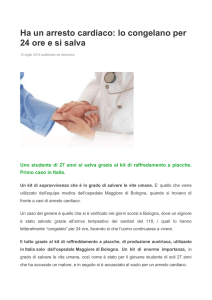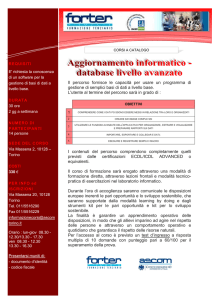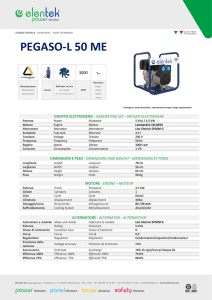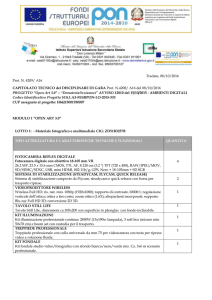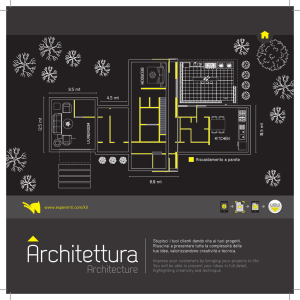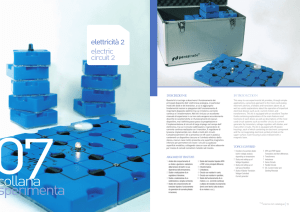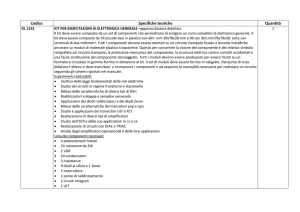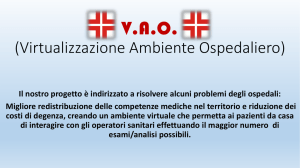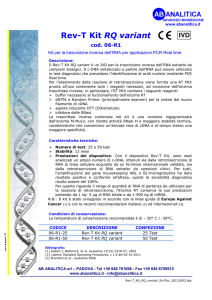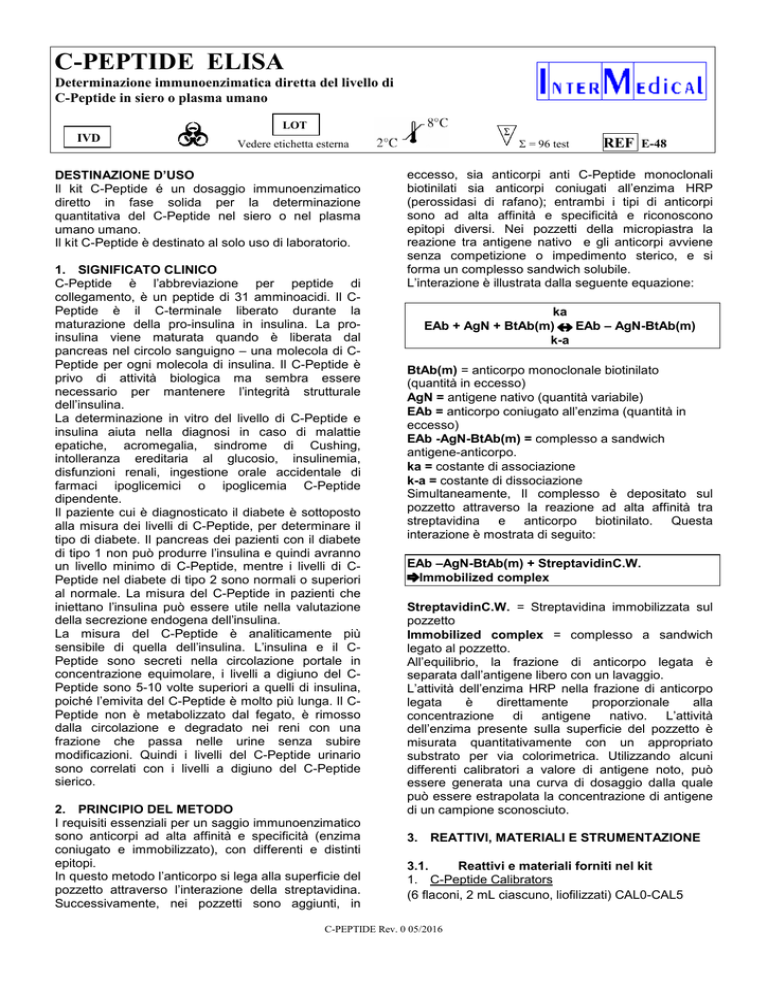
C-PEPTIDE ELISA
Determinazione immunoenzimatica diretta del livello di
C-Peptide in siero o plasma umano
LOT
IVD
Σ = 96 test
Vedere etichetta esterna
DESTINAZIONE D’USO
Il kit C-Peptide é un dosaggio immunoenzimatico
diretto in fase solida per la determinazione
quantitativa del C-Peptide nel siero o nel plasma
umano umano.
Il kit C-Peptide è destinato al solo uso di laboratorio.
1. SIGNIFICATO CLINICO
C-Peptide è l'abbreviazione per peptide di
collegamento, è un peptide di 31 amminoacidi. Il CPeptide è il C-terminale liberato durante la
maturazione della pro-insulina in insulina. La proinsulina viene maturata quando è liberata dal
pancreas nel circolo sanguigno – una molecola di CPeptide per ogni molecola di insulina. Il C-Peptide è
privo di attività biologica ma sembra essere
necessario per mantenere l'integrità strutturale
dell’insulina.
La determinazione in vitro del livello di C-Peptide e
insulina aiuta nella diagnosi in caso di malattie
epatiche, acromegalia, sindrome di Cushing,
intolleranza ereditaria al glucosio, insulinemia,
disfunzioni renali, ingestione orale accidentale di
farmaci ipoglicemici o ipoglicemia C-Peptide
dipendente.
Il paziente cui è diagnosticato il diabete è sottoposto
alla misura dei livelli di C-Peptide, per determinare il
tipo di diabete. Il pancreas dei pazienti con il diabete
di tipo 1 non può produrre l'insulina e quindi avranno
un livello minimo di C-Peptide, mentre i livelli di CPeptide nel diabete di tipo 2 sono normali o superiori
al normale. La misura del C-Peptide in pazienti che
iniettano l'insulina può essere utile nella valutazione
della secrezione endogena dell'insulina.
La misura del C-Peptide è analiticamente più
sensibile di quella dell'insulina. L'insulina e il CPeptide sono secreti nella circolazione portale in
concentrazione equimolare, i livelli a digiuno del CPeptide sono 5-10 volte superiori a quelli di insulina,
poiché l’emivita del C-Peptide è molto più lunga. Il CPeptide non è metabolizzato dal fegato, è rimosso
dalla circolazione e degradato nei reni con una
frazione che passa nelle urine senza subire
modificazioni. Quindi i livelli del C-Peptide urinario
sono correlati con i livelli a digiuno del C-Peptide
sierico.
2. PRINCIPIO DEL METODO
I requisiti essenziali per un saggio immunoenzimatico
sono anticorpi ad alta affinità e specificità (enzima
coniugato e immobilizzato), con differenti e distinti
epitopi.
In questo metodo l’anticorpo si lega alla superficie del
pozzetto attraverso l’interazione della streptavidina.
Successivamente, nei pozzetti sono aggiunti, in
REF E-48
eccesso, sia anticorpi anti C-Peptide monoclonali
biotinilati sia anticorpi coniugati all’enzima HRP
(perossidasi di rafano); entrambi i tipi di anticorpi
sono ad alta affinità e specificità e riconoscono
epitopi diversi. Nei pozzetti della micropiastra la
reazione tra antigene nativo e gli anticorpi avviene
senza competizione o impedimento sterico, e si
forma un complesso sandwich solubile.
L’interazione è illustrata dalla seguente equazione:
ka
EAb + AgN + BtAb(m) EAb – AgN-BtAb(m)
k-a
BtAb(m) = anticorpo monoclonale biotinilato
(quantità in eccesso)
AgN = antigene nativo (quantità variabile)
EAb = anticorpo coniugato all’enzima (quantità in
eccesso)
EAb -AgN-BtAb(m) = complesso a sandwich
antigene-anticorpo.
ka = costante di associazione
k-a = costante di dissociazione
Simultaneamente, Il complesso è depositato sul
pozzetto attraverso la reazione ad alta affinità tra
streptavidina e anticorpo biotinilato. Questa
interazione è mostrata di seguito:
EAb –AgN-BtAb(m) + StreptavidinC.W.
Immobilized complex
StreptavidinC.W. = Streptavidina immobilizzata sul
pozzetto
Immobilized complex = complesso a sandwich
legato al pozzetto.
All’equilibrio, la frazione di anticorpo legata è
separata dall’antigene libero con un lavaggio.
L’attività dell’enzima HRP nella frazione di anticorpo
legata
è
direttamente
proporzionale
alla
concentrazione di antigene nativo. L’attività
dell’enzima presente sulla superficie del pozzetto è
misurata quantitativamente con un appropriato
substrato per via colorimetrica. Utilizzando alcuni
differenti calibratori a valore di antigene noto, può
essere generata una curva di dosaggio dalla quale
può essere estrapolata la concentrazione di antigene
di un campione sconosciuto.
3. REATTIVI, MATERIALI E STRUMENTAZIONE
3.1.
Reattivi e materiali forniti nel kit
1. C-Peptide Calibrators
(6 flaconi, 2 mL ciascuno, liofilizzati) CAL0-CAL5
C-PEPTIDE Rev. 0 05/2016
2. Conjugate (1 flacone, 13 mL)
Anticorpi anti C-Peptide coniugato a perossidasi di
rafano (HRP) e anti-C-Peptide biotinilato
•
•
3. Coated Microplate (1 micropiastra breakable)
Micropiastra coattata con streptavidina
4. TMB Substrate (1 flacone, 15 mL)
H2O2-TMB (0,26 g/L) (evitare il contatto con la pelle)
5. Stop solution (1 flacone, 15 mL)
Acido Solforico 0,15 mol/L (evitare il contatto con la
pelle)
6. 50X Conc. Wash Solution (1 flacone, 20 mL)
NaCl 45 g/L; Tween-20 55 g/L
3.2.
Reattivi necessari non forniti nel kit
Acqua distillata.
3.3.
Materiale e strumentazione ausiliare
Dispensatori automatici.
Lettore per micropiastre (450 nm)
Note
Conservare tutti i reattivi a 28°C al riparo dalla
luce.
Aprire la busta del reattivo 3 (Coated Microplate)
solo dopo averla riportata a temperatura ambiente e
chiuderla subito dopo il prelievo delle strip da
utilizzare.
4. AVVERTENZE
• Questo test kit è per uso in vitro, da eseguire da
parte di personale esperto. Non per uso interno o
esterno su esseri Umani o Animali.
• Usare i previsti dispositivi di protezione individuale
mentre si lavora con i reagenti forniti.
• Seguire le Buone Pratiche di Laboratorio (GLP)
per la manipolazione di prodotti derivati da
sangue.
• Tutti i reattivi di origine umana usati nella
preparazione dei reagenti sono stati testati e sono
risultati negativi per la presenza di anticorpi antiHIV 1&2, per HbsAg e per anticorpi anti-HCV.
Tuttavia nessun test offre la certezza completa
dell’assenza di HIV, HBV, HCV o di altri agenti
infettivi. Pertanto, i Calibratori devono essere
maneggiati come materiali potenzialmente infettivi.
• Alcuni reagenti contengono piccole quantità di
R
Proclin 300 come conservante. Evitare il contatto
con la pelle e le mucose.
• Il TMB Substrato contiene un irritante, che può
essere dannoso se inalato, ingerito o assorbito
attraverso la cute. Per prevenire lesioni, evitare
l’inalazione, l’ingestione o il contatto con la cute e
con gli occhi.
• La Stop Solution è costituita da una soluzione di
acido solforico diluito. L’acido solforico è velenoso
e corrosivo e può essere tossico se ingerito. Per
prevenire possibili ustioni chimiche, evitare il
contatto con la cute e con gli occhi.
Evitare l’esposizione del reagente TMB/H2O2 a
luce solare diretta, metalli o ossidanti. Non
congelare la soluzione.
Questo metodo permette la determinazione
quantitativa di C-Peptide da 0,2 a 10,0 ng/mL.
5. PRECAUZIONI
• Si prega di attenersi rigorosamente alla sequenza
dei passaggi indicata in questo protocollo. I
risultati presentati qui sono stati ottenuti usando
specifici reagenti elencati in queste Istruzioni per
l’Uso.
• Tutti i reattivi devono essere conservati a
temperatura controllata di 2-8°C nei loro
contenitori originali. Eventuali eccezioni sono
chiaramente indicate. I reagenti sono stabili fino
alla data di scadenza se conservati e trattati
seguendo le istruzioni fornite.
• Prima dell’uso lasciare tutti i componenti dei kit e i
campioni a temperatura ambiente (22-28°C) e
mescolare accuratamente.
• Non scambiare componenti dei kit di lotti diversi.
Devono essere osservate le date di scadenza
riportate sulle etichette della scatola e di tutte le
fiale. Non utilizzare componenti oltre la data di
scadenza.
• Qualora si utilizzi strumentazione automatica, è
responsabilità dell’utilizzatore assicurarsi che il kit
sia stato opportunamente validato.
• Un lavaggio incompleto o non accurato dei
pozzetti può causare una scarsa precisione e/o
un’elevato background.
• Per la riproducibilità dei risultati, è importante che
il tempo di reazione di ogni pozzetto sia lo stesso.
Per evitare il time shifting durante la
dispensazione degli reagenti, il tempo di
dispensazione dei pozzetti non dovrebbe
estendersi oltre i 10 minuti. Se si protrae oltre, si
raccomanda di seguire lo stesso ordine di
dispensazione. Se si utilizza più di una piastra, si
raccomanda di ripetere la curva di calibrazione in
ogni piastra.
• L’addizione del TMB Substrato dà inizio ad una
reazione cinetica, la quale termina con l’addizione
della Stop Solution. L’addizione del TMB
Substrato e della Stop Solution deve avvenire
nella stessa sequenza per evitare tempi di
reazione differenti.
• Osservare le linee guida per l’esecuzione del
controllo di qualità nei laboratori clinici testando
controlli e/o pool di sieri.
• Osservare
la
massima
precisione
nella
ricostituzione e dispensazione dei reagenti.
• Non
usare
campioni
microbiologicamente
contaminati, altamente lipemici o emolizzati.
• I lettori di micropiastre leggono l’assorbanza
verticalmente. Non toccare il fondo dei pozzetti.
C-PEPTIDE Rev. 0 05/2016
6. PROCEDIMENTO
6.1.
Preparazione dei Calibratori (C0…C5)
I Calibratori sono stati calibrati usando una soluzione
st
di riferimento, la quale è stata dosata contro il 1 IRR
84/510.
I Calibratori hanno le seguenti concentrazioni:
C0
C1
C2
C3
C4
C5
ng/mL
0
0,2
1,0
2,0
5,0
10,0
Ricostituire ogni flacone con 2 mL di acqua
distillata o deionizzata.
I Calibratori ricostituiti sono stabili 7 giorni a 2÷8°C.
Per periodi più lunghi aliquotare i Calibratori in
appositi flaconcini conservarli a -20°C (stabili per 6
mesi). Scongelare una sola volta.
6.2.
Preparazione della Wash Solution
Prima dell’uso, diluire il contenuto di ogni fiala di "50X
Conc. Wash Solution" con acqua distillata fino al
volume di 1000 mL. Per preparare volumi minori
rispettare il rapporto di diluizione di 1:50. La soluzione
di lavaggio diluita è stabile a 2÷8°C per almeno 30
giorni.
6.3.
Preparazione del campione
Seguire le buone norme di laboratorio nell’utilizzo di
prodotti a base di sangue.
Per un accurato confronto al fine di determinare i
valori normali , dovrebbero essere prelevati campioni
di siero la mattina a digiuno.
Per ottenere il siero, il sangue dovrebbe essere
raccolto in un tubo per prelievi senza additivi o
anticoagulanti; permettere al sangue di coagularsi;
centrifugare il campione per separare il siero dalle
cellule.
I campioni dovrebbero essere refrigerati a 2÷8°C per
un periodo massimo di 5 giorni. Se non possono
essere dosati entro questo tempo, dovrebbero essere
conservati a -20°C fino a 30 giorni. Evitare ripetuti
cicli di congelamento e scongelamento.
Campioni di pazienti con concentrazioni di C-Peptide
al di sopra dei 10 ng/mL possono essere diluiti (ad
esempio 1:10 o superiori) con il Calibratore 0 e testati
di nuovo. La concentrazione dei campioni si ottiene
moltiplicando il risultato per il fattore di diluizione.
6.4.
Procedimento
• Portare tutti i reagenti a temperatura ambiente
(22-28°C).
• Le strisce di pozzetti non utilizzate devono essere
rimesse immediatamente nella busta richiudibile
contenente il materiale essicante e conservate a
2-8°C.
• Per evitare potenziali contaminazioni microbiche
e/o chimiche non rimettere i reagenti inutilizzati nei
flaconi originali.
• Al fine di aumentare l’accuratezza dei risultati del
test è necessario operare in doppio, allestendo
due pozzetti per ogni punto della curva di
calibrazione (C0-C5), due per ogni Controllo, due
per ogni Campione ed uno per il Bianco.
Reagente
Calibratore
Calibratori
C0-C5
Bianco
50 µL
Campione
Coniugato
Campione
50 µL
100 µL
100 µL
Incubare 2 h a temperatura ambiente (22÷28°C).
Rimuovere il contenuto da ogni pozzetto e lavare 3
volte con 300 μL di soluzione di lavaggio diluita.
TMB
Substrate
100 µL
100 µL
Incubare 15 minuti a temperatura
(22÷28°C), al riparo dalla luce
100 µL
ambiente
Stop
100 µL
100 µL
100 µL
Solution
Agitare delicatamente la micropiastra.
Leggere l’assorbanza (E) a 450 nm azzerando con il
Bianco entro 5 minuti.
7. CONTROLLO QUALITA’
Ogni laboratorio dovrebbe testare i controlli a valori
bassi, medi e alti della curva di calibrazione per
monitorare le performance del kit. Questi controlli
dovrebbero essere trattati come sconosciuti ed i
valori determinati in ogni procedura analitica
eseguita. Tabelle di controllo di qualità dovrebbero
essere effettuate per seguire le prestazioni dei
reagenti forniti. Metodi statistici pertinenti dovrebbero
essere usati per accertarne le tendenze. Deviazioni
significative dalle prestazioni stabilite possono
indicare un cambiamento inosservato nelle condizioni
sperimentali o il decadimento dei reattivi del kit.
Reattivi freschi dovrebbero essere utilizzati per
determinare la causa delle variazioni.
8. RISULTATI
8.1.
Note
La densità ottica (O.D.) di alcuni tra calibratori e
campioni potrebbe risultare maggiore di 2,0, in
questo caso, potrebbero essere fuori dal range di
misura del lettore di micropiastra. É quindi
necessario, per O.D. maggiori di 2,0 di effettuare una
lettura 405 nm (= lunghezza d’onda del picco sulla
spalla del principale) oltre che a 450 nm (lunghezza
d’onda del picco principale) e a 620 nm (filtro di
riferimento per la sottrazione delle interferenze
dovute alla plastica).
Per lettori di micropiastre non progettati per leggere la
piastra a tre differenti lunghezze d’onda allo stesso
tempo, é consigliabile di procedure nel seguente
modo:
- leggere la micropiastra a 450 nm ed a 620 nm.
- leggere ancora la piastra a 405 nm ed a 620 nm.
- trovare i pozzetti le cui ODs a 450 nm sono maggiori
di 2.0
C-PEPTIDE Rev. 0 05/2016
- selezionare le corrispondenti OD lette a 405 nm e
moltiplicare questi valori a 405 nm per il fattore di
conversione 3.0 (dove OD 450/OD 405 = 3,0), che è:
OD 450 nm = OD 405 nm x 3,0.
Attenzione: Il fattore di conversione 3,0 é solamente
suggerito. Per una migliore accuratezza, l’utente è
invitato a calcolarsi il fattore di conversione specifico
per il proprio lettore.
8.2.
Estinzione Media
Calcolare l’estinzione media (Em) di ciascun punto
della curva di calibrazione (C0-C5) e di ogni
campione.
8.3.
Curva di calibrazione
– Metodo automatico
Usare la 4 parametri logistic – preferita – oppure la
funzione smoothed cubic spline come algoritmo di
calcolo.
8.4.
Curva di calibrazione
– Metodo manuale
Una curva dose-risposta è usata per determinare la
concentrazione di C-Peptide in un campione
sconosciuto.
Registrare le OD ottenute dal tabulato del lettore della
micropiastra.
Mettere in grafico le OD per ogni duplicato degli
Calibratori contro le concentrazioni corrispondenti di
C-Peptide in ng/mL su carta lineare (non mediare i
duplicati dei calibratori prima del plottaggio).
Disegnare la migliore curva che fitti i valori attraverso
i punti disegnati.
Per determinare la concentrazione di C-Peptide per
un campione incognito, localizzare la OD media dei
duplicati dei campioni incogniti corrispondenti
sull’asse verticale del grafico, trovare il punto di
intersezione sulla curva e leggere la concentrazione
(in ng/mL) sull’asse orizzontale del grafico (è
possibile ricavare la media dei duplicati del campione
incognito come indicato).
9. VALORI DI RIFERIMENTO
I valori di C-Peptide sono consistentemente più alti in
plasma che in siero; tuttavia è preferibile usare serio.
I range sono stati assegnati basandosi sui dati clinici
in accordo con i lavori pubblicati in letteratura
Adulti (Normali)
C-Peptide
0,7 – 1,9 ng/mL
È importante tenere presente che la determinazione
di un range di valori attesi in un dato metodo per una
popolazione “normale” è dipendente da molteplici
fattori, quali la specificità e sensibilità del metodo in
uso, e la popolazione in esame. Perciò ogni
laboratorio dovrebbe considerare i range indicati dal
Fabbricante come un’indicazione generale e produrre
range di valori attesi propri basati sulla popolazione
indigena dove il laboratorio risiede.
10. PARAMETRI CARATTERISTICI
10.1.
Precisione
10.1.1.
Intra-Assay
La variabilità all’interno dello stesso kit è stata
determinata replicando (16x) la misura di tre differenti
sieri di controllo. La variabilità intra-assay è ≤ 6,2%.
10.1.2.
Inter-Assay
La variabilità tra kit differenti è stata determinata
replicando (20x) la misura di tre differenti sieri di
controllo con kit appartenenti a lotti diversi. La
variabilità inter-assay è ≤ 10.0%.
10.2.
Sensibilità
La concentrazione minima di C-Peptide misurabile
che può essere distinta dal Calibratore 0 è 0,01
ng/mL con un limite di confidenza del 95%.
10.3.
Specificità
L’anticorpo impiegato presenta le seguenti reazioni
crociate,
valutata
aggiungendo
le
sostanze
interferenti. La cross reattività è stata calcolata
derivando il rapporto tra dose di sostanze interferenti
su dose di C-Peptide necessaria per ottenere la
stessa assorbanza.
Cross Reagente
Conc. Testata
Ottenuta
C-Peptide
Insulin
Proinsulin
--10000 μIU/mL
1000 ng/mL
--N.D.
N.D.
Cross
Reattività
100 %
Non Rilevata
Non Rilevata
10.4.
Correlazione
Il kit C-Peptide INTERMEDICAL è stato comparato
con un kit disponibile in commercio. Sono stati testati
194 campioni di siero.
La curva di regressione è:
y = 1,012 x + 0,025
2
r = 0,991
y = C-Peptide kit commerciale
x = C-Peptide INTERMEDICAL kit
11. DISPOSIZIONI PER LO SMALTIMENTO
I reagenti devono essere smaltiti in accordo con le
leggi locali
BIBLIOGRAFIA
̵
Eastham R.D: Biochemical Values in Clinical
th
Medicine, 7
Ed. Bristol. England. Jonh Wright
&Sons, Ltd;. (1985).
̵
Gerbitz, V.K.D, J.Clin.Chem.Biochem. 18, 313326 (1980)
̵
Boehm TM, et al Diabetes Care 479-490. (1079)
̵
National Committee for Clinical Laboratory
Standards. Procedure for the collection of
diagnostic blood specimensby venipuncture:
th
approved standards. 4 Ed. NCCLS Document
H3-A4, Wayne, PA(1988).
̵
Turkinton RW, et al Archive of Internal Med. 142
̵
Sacks BD Carbohydrates in Burtis, C.A. and
Ashwood, AR (Eds ) Tietz Textbook OF Clinical
nd
Chemistry.2 Ed. Philadelphia w.B. Saunders Co.
1994
C-PEPTIDE Rev. 0 05/2016
̵
Kahn CR, et al Diabetes Care
(1979)
2, 283 – 295
Contatti:
InterMedical S.r.l. Via A.Genovesi,13 80010
Villaricca (NA) ITALY - Tel. +39 81 330 27 05 Fax
+39 81 330 14 53
P. IVA 03426331215
e-mail product specialist :
[email protected]
Fabbricante
INTERMEDICAL s.r.l.
Via A. Genovesi,13
80010 Villaricca(Na)-ITALY
C-PEPTIDE Rev. 0 05/2016
C-PEPTIDE ELISA
Direct immunoenzymatic determination of C-Peptide
level in human serum or plasma
LOT
IVD
Σ = 96 tests
See external label
INTENDED USE
C-Peptide kit is a direct solid phase enzyme
immunoassay for quantitative determination of CPeptide in human serum or plasma.
C-Peptide kit is intended for laboratory use only.
1. CLINICAL SIGNIFICANCE
C-Peptide is the abbreviation for connecting peptide,
it is a 31-amminoacid peptide. C-Peptide of insulin is
the C-terminal cleavage product produced during
processing of the insulin prohormone to the mature
insulin molecule. Proinsulin is splited when it is
released from the pancreas into the blood - one CPeptide for each insulin molecule. C-Peptide is devoid
of any biological activity but appears to be necessary
to maintain the structural integrity of Insulin.
In-vitro determination of Insulin and C-Peptide level
help in differential diagnosis of liver disease,
acromegaly, Cushing sindrome, familial glucose
intolerance, Insulinimia, renal failure, ingestion of
accidental oral hypoglicemic drugs or C-Peptide
induced factitious hypoglicemia.
Newly diagnosed diabetes patient often get their CPeptide levels measured, to find if they are type 1
diabetes or type 2 diabetes. The pancreas of patients
with type 1 diabetes is unable to produce insulin and
they will therefore usually have a decreased level of
C-Peptide, while C-Peptide levels in type 2 patients is
normal or higher than normal. Measuring C-Peptide in
patients injecting insulin can help to determine how
much of their own natural insulin these patients are
still producing.
C-Peptide assays may be analytically more sensitive
than insulin assays. Measurement of the C-Peptide
may be useful in evaluating endogenous insulin
secretion in a variety of clinical conditions. Insulin and
C-Peptide are secreted into portal circulation in
equimolar concentrations, fasting levels of C-Peptide
are 5 – 10 fold higher than those of Insulin owing to
the longer half-life of C-Peptide. The liver does not
extract C-Peptide however; it is removed from the
circulation by degradation in the kidneys with a
fraction passing out unchanged in urine. Hence the
urine C-Peptide levels correlate well with fasting CPeptide levels in serum.
2. PRINCIPLE
The
essential
reagents
required
for
an
immunoenzymometric assay include high affinity and
specificity
antibodies
(enzyme-linked
and
immobilized), whit different and distinct epitope
recognition, in excess, and native antigen. In this
procedure, the immobilization takes place during the
assay at the surface of a microplate well through the
REF E-48
interaction of the streptavidin coated on the well and
exogenously added biotinylated monoclonal anti CPeptide antibody (Ab).
Upon mixing the monoclonal biotinylated antibody, the
enzyme-labelled antibody and a serum containing the
native antigen (Ag), a reaction results between the
native antigen and the antibodies, without competition
or steric hindrance, to form a soluble sandwich
complex.
The interaction is illustrated in the following equation:
ka
EAb + AgN + BtAb(m) EAb – AgN – BtAb(m)
k-a
BtAb(m) = biotinylated monoclonal antibody (excess
quantity)
AgN = native antigen (variable quantity)
EAb = enzyme labelled antibody (excess quantity)
EAb – AgN – BtAb(m) = antigen-antibodies sandwich
complex
ka = rate constant of association
k-a = rate constant of dissociation
Simultaneously, the complex is deposited into the well
through the high affinity reaction of streptavidin and
biotinylated antibody.
This interaction is illustrated below:
EAb –AgN – BtAb(m) + StreptavidinC.W.
Immobilized complex
StreptavidinC.W. = Streptavidin immobilized on well
Immobilized complex = sandwich complex bound to
the well
After equilibrium is attained, the antibody-bound
fraction is separated from unbound antigen by a
washing step. The enzyme activity in the antibodybound fraction is directly proportional to the native
antigen concentration. The activity of the enzyme
present on the surface of the well is quantitated by
reaction with a suitable substrate to produce colour.
By utilizing several different calibrators of known
antigen values, a dose response curve can be
generated from which the antigen concentration of an
unknown can be ascertained.
3.
REAGENTS, MATERIALS AND INSTRUMENTATION
3.1. Reagents and materials supplied in the kit
1. C-Peptide Calibrators
(6 vials, 2 mL each, lyophilized)M CAL0-CAL5
C-PEPTIDE Rev. 0 05/2016
2. Conjugate (1 vial, 13 mL)
Antibodies anti C-Peptide conjugated with horseradish
peroxidase (HRP) and anti C-Peptide biotinilated
Coated Microplate
(1 breakable microplate)
Microplate coated with streptavidin
5.
•
•
3. TMB Substrate (1 vial, 15 mL)
H2O2-TMB 0.26 g/L (avoid any skin contact)
4. Stop Solution (1 vial, 15 mL)
Sulphuric acid 0.15 mol/L (avoid any skin contact)
•
•
5. 50X Conc. Wash Solution (1 vial, 20 mL)
NaCl 45 g/L; Tween-20 55 g/L
•
3.2. Reagents necessary not supplied
Distilled water.
3.3. Auxiliary materials and instrumentation
Automatic dispenser.
Microplates reader (450 nm)
•
•
Note
Store all reagents between 28°C in the dark.
Open the bag of reagent 3 (Coated Microplate) only
when it is at room temperature and close it
immediately after use.
4.
•
•
•
•
•
•
•
•
•
WARNINGS
This kit is intended for in vitro use by professional
persons only. Not for internal or external use in
Humans or Animals.
Use appropriate personal protective equipment
while working with the reagents provided.
Follow Good Laboratory Practice (GLP) for
handling blood products.
All human source material used in the preparation
of the reagents has been tested and found
negative for antibody to HIV 1&2, HbsAg, and
HCV. No test method however can offer complete
assurance that HIV, HBV, HCV or other infectious
agents are absent. Therefore, the Calibrators
should be handled in the same manner as
potentially infectious material.
Some reagents contain small amounts of Proclin
R
300 as preservative. Avoid the contact with skin
or mucosa.
The TMB Substrate contains an irritant, which may
be harmful if inhaled, ingested or absorbed
through the skin. To prevent injury, avoid
inhalation, ingestion or contact with skin and eyes.
The Stop Solution consists of a diluted sulphuric
acid solution. Sulphuric acid is poisonous and
corrosive and can be toxic if ingested. To prevent
chemical burns, avoid contact with skin and eyes.
Avoid the exposure of reagent TMB/H2O2 to
directed sunlight, metals or oxidants. Do not
freeze the solution.
This method allows the quantitative determination
of C-Peptide from 0.2 to 10.0 ng/mL.
•
•
•
•
•
6.
PRECAUTIONS
Please adhere strictly to the sequence of pipetting
steps provided in this protocol. The performance
data represented here were obtained using
specific reagents listed in this Instruction For Use.
All reagents should be stored refrigerated at 2-8°C
in their original container. Any exceptions are
clearly indicated. The reagents are stable until the
expiry date when stored and handled as indicated.
Allow all kit components and specimens to reach
room temperature (22-28°C) and mix well prior to
use.
Do not interchange kit components from different
lots. The expiry date printed on box and vials
labels must be observed. Do not use any kit
component beyond their expiry date.
If you use automated equipment, the user has the
responsibility to make sure that the kit has been
appropriately tested.
The incomplete or inaccurate liquid removal from
the wells could influence the assay precision
and/or increase the background.
It is important that the time of reaction in each well
is held constant for reproducible results. Pipetting
of samples should not extend beyond ten minutes
to avoid assay drift. If more than 10 minutes are
needed, follow the same order of dispensation. If
more than one plate is used, it is recommended to
repeat the dose response curve in each plate
Addition of the TMB Substrate solution initiates a
kinetic reaction, which is terminated by the
addition of the Stop Solution. Therefore, the TMB
Substrate and the Stop Solution should be added
in the same sequence to eliminate any time
deviation during the reaction.
Observe the guidelines for performing quality
control in medical laboratories by assaying
controls and/or pooled sera.
Maximum precision is required for reconstitution
and dispensation of reagents.
Samples microbiologically contaminated, highly
lipemeic or haemolysed should not be used in the
assay.
Plate readers measure vertically. Do not touch the
bottom of the wells.
PROCEDURE
6.1. Preparation of the Calibrator (C0…C5)
The Calibrators were calibrated using a reference
st
preparation, which was assayed against the WHO 1
IRR 84/510.
The Calibrators have the following concentration:
C0
C1
C2
C3
C4
C5
ng/mL
0
0,2
1,0
2,0
5,0
10,0
Reconstitute each Calibrator with 2 mL of distilled
or deionised water.
Once reconstituted, the Calibrators are stable 7 days
at 2-8°C.
In order to store for a longer period aliquot the
reconstituted calibrators in vials and store them at
C-PEPTIDE Rev. 0 05/2016
-20°C (stable 6 months). Do not freeze and thaw
more than once.
6.2. Preparation of Wash Solution
Dilute the content of each vial of the "50X Conc.
Wash Solution" with distilled water to a final volume of
1000 mL prior to use. For smaller volumes respect
the 1:50 dilution ratio. The diluted wash solution is
stable for 30 days at 2÷8°C.
6.3. Preparation of the Sample
Follow the good laboratory procedures for handling
blood products.
For accurate comparison to established normal
values, a fasting morning serum sample should be
obtained.
To obtain the serum, the blood should be collected in
a venipuncture tube without additives or anticoagulants; allow the blood to clot; centrifuge the
specimen to separate the serum from the cells.
Samples may be refrigerated at 2÷8°C for a
maximum period of 5 days. If the specimens cannot
be assayed within this time, they must be stored at 20°C for up to 30 days. Avoid repetitive freezing and
thawing.
Patient specimens with C-Peptide concentrations
above 10 ng/mL may be diluted (for example 1:10 or
higher) with the Calibrator 0 (C-Peptide 0 ng/mL) and
re-assayed. The sample’s concentration is obtained
by multiplying the result by the dilution factor.
•
•
•
•
6.4. procedure
Allow all reagents to reach room temperature
(22-28°C).
Unused coated microwell strips should be
released securely in the foil pouch containing
desiccant and stored at 2-8°C.
To avoid potential microbial and/or chemical
contamination, unused reagents should never be
transferred into the original vials.
As it is necessary to perform the determination in
duplicate in order to improve accuracy of the test
results, prepare two wells for each point of the
calibration curve (C0-C5), two for each Control, two
for each sample, one for Blank.
Reagent
Calibrator
C0-C5
Calibrator
Blank
50 µL
Sample
Conjugate
Sample
50 µL
100 µL
100 µL
Incubate at room temperature (22-28°C) for 2 hour.
Remove the content from each well. Wash the wells
3 times with 300 μL of diluted Wash Solution.
TMB
100 µL
100 µL
100 µL
Substrate
Incubate at room temperature (22-28°C) for 15
minutes in the dark.
Stop Solution
100 µL
100 µL
100 µL
Shake the microplate gently.
Read the absorbance (E) at 450 nm against Blank
within 5 minutes.
7. QUALITY CONTROL
Each laboratory should assay controls at levels in the
low, medium and high ranges of the dose response
curve for monitoring assay performance. These
controls should be treated as unknowns and values
determined in every test procedure performed.
Quality control charts should be maintained to follow
the performance of the supplied reagents. Pertinent
statistical methods should be employed to ascertain
trends. Significant deviation from established
performance can indicate unnoticed change in
experimental conditions or degradation of kit
reagents. Fresh reagents should be used to
determine the reason for the variations.
8.
RESULTS
8.1. Note
The optical densities (O.D.) of some calibrators and
samples may be higher than 2.0 , in such a case, they
could be out of the measurement range of the
microplate reader. It is therefore necessary, for O.D.
higher than 2.0, to perform a reading at 405 nm
(=wavelength of peak shoulder) in addition to 450 nm
(peak wavelength) and 620 nm (reference filter for the
subtraction of interferences due to the plastic).
For microplate readers unable to read the plate at 3
wavelengths at the same time,
it is advisable to proceed as follows:
- Read the microplate at 450 nm and at 620 nm.
- Read again the plate at 405 nm and 620 nm.
- Find out the wells whose OD at 450 nm are higher
than 2.0
- Select the corresponding ODs read at 405 nm and
multiply these values at 405 nm by the conversion
factor 3.0 (where OD 450/OD 405 = 3.0), that is: OD
450 nm = OD 405 nm x 3.0.
C-PEPTIDE Rev. 0 05/2016
Warning: The conversion factor 3.0 is suggested only.
For better accuracy, the user is advised to calculate
the conversion factor specific for his own reader.
8.2. Mean Absorbance
Calculate the mean of the absorbance (Em) for each
point of the calibration curve and of each sample.
8.3. Calibration curve – Automatic method
Use the 4 parameters logistic – preferred – or the
smoothed cubic spline function as calculation
algorithm.
8.4. Calibration curve – Manual method
A dose response curve is used to ascertain the
concentration of C-Peptide in unknown specimens.
Record the OD obtained from the printout of the
microplate reader.
Plot the OD for each duplicate calibrator versus the
corresponding C-Peptide concentration in ng/mL on
linear graph paper (do not average the duplicates of
the calibrators before plotting).
Draw the best-fit curve through the plotted points.
To determine the concentration of C-Peptide for an
unknown, locate the average absorbance of the
duplicates for each unknown on the vertical axis of
the graph, find the intersecting point on the curve, and
read the concentration (in ng/mL) from the horizontal
axis of the graph (the duplicates of the unknown may
be averaged as indicated).
9. REFERENCE VALUES
C-Peptide values are consistently higher in plasma
than in serum; thus, serum is preferred. Compared
with fasting values
In concordance with the published literature the
following ranges have been assigned.
Adult (Normal)
C-Peptide
0,7 – 1,9 ng/mL
Please pay attention to the fact that the determination
of a range of expected values for a “normal”
population in a given method is dependent on many
factors, such as specificity and sensitivity of the
method used and type of population under
investigation. Therefore each laboratory should
consider the range given by the Manufacurer as a
general indication and produce their own range of
expected values based on the indigenous population
where the laboratory works.
10. PERFORMANCE AND CHARACTERISTICS
10.1. Precision
10.1.1. Intra Assay
Within run variation was determined by replicate
measurements (16x) of three different control sera in
one assay. The within assay variability is ≤ 6.2%.
10.1.2. Inter Assay
Between run variation was determined by replicate
measurements (20x) of three different control sera in
different lots. The between assay variability is ≤
10.0%.
10.2. Sensitivity
The lowest detectable concentration of C-Peptide that
can be distinguished from the Calibrator 0 is 0.01
ng/mL at the 95 % confidence limit.
10.3. Specificity
The cross reactivity of the C-Peptide ELISA method
to selected substances was evaluated by adding the
interfering substance. The cross reactivity was
calculated by deriving a ratio between dose of
interfering substance to dose of C -Peptide needed
to produce the same absorbance.
Cross Reagent
Conc. Tested
Obtained
C-Peptide
Insulin
Proinsulin
--10000 μIU/mL
1000 ng/mL
--N.D.
N.D.
Cross
Reactivity
100 %
Not Detected
Not Detected
10.4. Correlation
INTERMEDICAL C-Peptide ELISA was compared to
another commercially available C-Peptide assay. 194
Serum samples were analysed according in both test
systems.
The linear regression curve was calculated
y = 1.012 x + 0.025
2
r = 0.991
y = C-Peptide commercial kit
x = C-Peptide INTERMEDICAL kit
11. WASTE MANAGEMENT
Reagents must be disposed off in accordance with
local regulations.
BIBLIOGRAPHY
̵
Eastham R.D: Biochemical Values in Clinical
th
Medicine, 7
Ed. Bristol. England. Jonh Wright
&Sons, Ltd;. (1985).
̵
Gerbitz, V.K.D., Pancreatische B-zellen Peptide:
Kinetic and Konzentration von Proinsulin Insulin
and C- Peptide in Plasma and Urin Probleme der
Mezmethoden Klinische und Literaturubersicht. J.
Clin. Chem. Biochem. 18, 313-326. (1980)
̵
Boehm TM, Lebovitz HE, statistical nalysis of
Glucose and Insulin responses to intravenous
tolbutamide: evaluetion of hypoglycemic and
hyperinsulinemic states: Diabetes Care 479-490.
(1079)
̵
National Committee for Clinical Laboratory
Standards. Procedure for the collection of
diagnostic blood specimensby venipuncture:
th
approved standards. 4 Ed. NCCLS Document
H3-A4, Wayne, PA(1988).
̵
Turkinton RW., Estkowski A., Link M. Secretion
of Insulin dependence of connecting peptide; a
predictor of insulin or dependence of obese
diabetics . Archive of Internal Med. 142
C-PEPTIDE Rev. 0 05/2016
̵
̵
Sacks BD: Carbohydrates in Burtis, C.A. and
Ashwood, AR (Eds ) Tietz Textbook OF Clinical
nd
Chemistry.2 Ed. Philadelphia W. .B. Saunders
Co. 1994
Kahn CR, Rosenthal AS, Immunologic reactions
to insulin, insulin allergy, insulin resistance and
autoimmune insulin syndrome. Diabetes Care 2,
283 – 295 (1979)
Contacts:
InterMedical S.r.l. Via A.Genovesi,13 80010 Villaricca
(NA) ITALY - Tel. +39 81 330 27 05 Fax +39 81 330
14 53
P. IVA 03426331215
e-mail product specialist :
[email protected]
Fabbricante
INTERMEDICAL s.r.l.
Via A. Genovesi,13
80010 Villaricca(Na)-ITALY
C-PEPTIDE Rev. 0 05/2016
INTERMEDICAL SRL
PACKAGING INFORMATION SHEET
IT
Spiegazione dei simboli
DE
FR
ES
Explication des symboles
Significado de los simbolos
PT
Verwendete Symbole
REF
yyyy-mm-dd
Σ = xx
Max
Min
GB
Explanation of symbols
Explicaçao dos simbolos
DE
ES
FR
GB
IT
PT
In vitro Diagnostikum
Producto sanitario para diagnóstico In vitro
Dispositif medical de diagnostic in vitro
In vitro Diagnostic Medical Device
Dispositivo medico-diagnostico in vitro
Dispositivos medicos de diagnostico in vitro
DE
ES
FR
GB
IT
PT
Hergestellt von
Elaborado por
Fabriqué par
Manufacturer
Produttore
Produzido por
DE
ES
FR
GB
IT
PT
Bestellnummer
Nûmero de catálogo
Réferéncès du catalogue
Catalogue number
Numero di Catalogo
Número do catálogo
DE
ES
FR
GB
IT
PT
Herstellungs datum
Fecha de fabricacion
Date de fabrication
Date of manufacture
Data di produzione
Data de produção
DE
ES
FR
GB
IT
PT
Verwendbar bis
Establa hasta (usar antes de último día del mes)
Utiliser avant (dernier jour du mois indiqué)
Use by (last day of the month)
Utilizzare prima del (ultimo giorno del mese)
Utilizar (antes ultimo dia do mês)
DE
ES
FR
GB
IT
PT
Biogefährdung
Riesco biológico
Risque biologique
Biological risk
Rischio biologico
Risco biológico
DE
ES
FR
GB
IT
PT
Gebrauchsanweisung beachten
Consultar las instrucciones
Consulter le mode d’emploi
Consult instructions for use
Consultare le istruzioni per l’uso
Consultar instruções para uso
DE
ES
FR
GB
IT
PT
Chargenbezeichnung
Codigo de lote
Numero de lot
Batch code
Codice del lotto
Codigo do lote
DE
ES
FR
GB
IT
PT
Ausreichend für “n” Tests
Contenido suficiente para ”n” tests
Contenu suffisant pour “n” tests
Contains sufficient for “n” tests
Contenuto sufficiente per “n” saggi
Contém o suficiente para “n” testes
DE
ES
FR
GB
IT
PT
Inhalt
Contenido del estuche
Contenu du coffret
Contents of kit
Contenuto del kit
Conteúdo do kit
DE
ES
FR
GB
IT
PT
Temperaturbereich
Límitaciôn de temperatura
Limites de température de conservation
Temperature limitation
Limiti di temperatura
Temperaturas limites de conservação
yyyy-mm
Cont.
INTERMEDICAL SRL
PACKAGING INFORMATION SHEET
SUGGERIMENTI PER LA RISOLUZIONE DEI PROBLEMI/TROUBLESHOOTING
ERRORE CAUSE POSSIBILI/ SUGGERIMENTI
Nessuna reazione colorimetrica del saggio
- mancata dispensazione del coniugato
- contaminazione del coniugato e/o del Substrato
- errori nell’esecuzione del saggio (es. Dispensazione accidentale dei reagenti in sequenza errata o provenienti da
flaconi sbagliati, etc.)
Reazione troppo blanda (OD troppo basse)
- coniugato non idoneo (es. non proveniente dal kit originale)
- tempo di incubazione troppo breve, temperatura di incubazione troppa bassa
Reazione troppo intensa (OD troppo alte)
- coniugato non idoneo (es. non proveniente dal kit originale)
- tempo di incubazione troppo lungo, temperatura di incubazione troppa alta
- qualità scadente dell’acqua usata per la soluzione di lavaggio (basso grado di deionizzazione)
- lavaggi insufficienti (coniugato non completamente rimosso)
Valori inspiegabilmente fuori scala
- contaminazione di pipette, puntali o contenitori- lavaggi insufficienti (coniugato non completamente rimosso)
CV% intra-assy elevato
- reagenti e/o strip non portate a temperatura ambiente prima dell’uso
- il lavatore per micropiastre non lava correttamente (suggerimento: pulire la testa del lavatore)
CV% intersaggio elevato
- condizioni di incubazione non costanti (tempo o temperatura)
- controlli e campioni non dispensati allo stesso tempo (con gli stessi intervalli) (controllare la sequenza di
dispensazione)
- variabilità intrinseca degli operatori
ERROR POSSIBLE CAUSES / SUGGESTIONS
No colorimetric reaction
- no conjugate pipetted reaction after addition
- contamination of conjugates and/or of substrate
- errors in performing the assay procedure (e.g. accidental pipetting of reagents in a wrong sequence or from the
wrong vial, etc.)
Too low reaction (too low ODs)
- incorrect conjugate (e.g. not from original kit)
- incubation time too short, incubation temperature too low
Too high reaction (too high ODs)
- incorrect conjugate (e.g. not from original kit)
- incubation time too long, incubation temperature too high
- water quality for wash buffer insufficient (low grade of deionization)
- insufficient washing (conjugates not properly removed)
Unexplainable outliers
- contamination of pipettes, tips or containers
insufficient washing (conjugates not properly removed) too high within-run
- reagents and/or strips not pre-warmed to CV% Room Temperature prior to use
- plate washer is not washing correctly (suggestion: clean washer head)
too high between-run - incubation conditions not constant (time, CV % temperature)
- controls and samples not dispensed at the same time (with the same intervals) (check pipetting order)
- person-related variation

